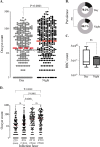The circadian clock modulates Anopheles gambiae infection with Plasmodium falciparum
- PMID: 36454885
- PMCID: PMC9714873
- DOI: 10.1371/journal.pone.0278484
The circadian clock modulates Anopheles gambiae infection with Plasmodium falciparum
Abstract
Key behaviours, physiologies and gene expressions in Anopheles mosquitoes impact the transmission of Plasmodium. Such mosquito factors are rhythmic to closely follow diel rhythms. Here, we set to explore the impact of the mosquito circadian rhythm on the tripartite interaction between the vector, the parasite and the midgut microbiota, and investigate how this may affect the parasite infection outcomes. We assess Plasmodium falciparum infection prevalence and intensity, as a proxy for gametocyte infectivity, in Anopheles gambiae mosquitoes that received a gametocyte-containing bloodfeed and measure the abundance of the midgut microbiota at different times of the mosquito rearing light-dark cycle. Gametocyte infectivity is also compared in mosquitoes reared and maintained under a reversed light-dark regime. The effect of the circadian clock on the infection outcome is also investigated through silencing of the CLOCK gene that is central in the regulation of animal circadian rhythms. The results reveal that the A. gambiae circadian cycle plays a key role in the intensity of infection of P. falciparum gametocytes. We show that parasite gametocytes are more infectious during the night-time, where standard membrane feeding assays (SMFAs) at different time points in the mosquito natural circadian rhythm demonstrate that gametocytes are more infectious when ingested at midnight than midday. When mosquitoes were cultured under a reversed light/dark regime, disrupting their natural physiological homeostasis, and infected with P. falciparum at evening hours, the infection intensity and prevalence were significantly decreased. Similar results were obtained in mosquitoes reared under the standard light/dark regime upon silencing of CLOCK, a key regulator of the circadian rhythm, highlighting the importance of the circadian rhythm for the mosquito vectorial capacity. At that time, the mosquito midgut microbiota load is significantly reduced, while the expression of lysozyme C-1 (LYSC-1) is elevated, which is involved in both the immune response and microbiota digestion. We conclude that the tripartite interactions between the mosquito vector, the malaria parasite and the mosquito gut microbiota are finely tuned to support and maintain malaria transmission. Our data add to the knowledge framework required for designing appropriate and biologically relevant SMFA protocols.
Copyright: © 2022 Habtewold et al. This is an open access article distributed under the terms of the Creative Commons Attribution License, which permits unrestricted use, distribution, and reproduction in any medium, provided the original author and source are credited.
Conflict of interest statement
The authors declare that no competing interests exist.
Figures



Similar articles
-
Artificial nighttime lighting impacts Plasmodium falciparum mature stage V gametocytes infectivity in Anopheles stephensi.Malar J. 2024 Feb 8;23(1):42. doi: 10.1186/s12936-024-04866-6. Malar J. 2024. PMID: 38326842 Free PMC article.
-
Circadian and daily rhythms of disease vector mosquitoes.Curr Opin Insect Sci. 2024 Jun;63:101179. doi: 10.1016/j.cois.2024.101179. Epub 2024 Feb 21. Curr Opin Insect Sci. 2024. PMID: 38395256 Free PMC article. Review.
-
Streamlined SMFA and mosquito dark-feeding regime significantly improve malaria transmission-blocking assay robustness and sensitivity.Malar J. 2019 Jan 25;18(1):24. doi: 10.1186/s12936-019-2663-8. Malar J. 2019. PMID: 30683107 Free PMC article.
-
Longitudinal impact of asymptomatic malaria/HIV-1 co-infection on Plasmodium falciparum gametocyte transcript expression and transmission to Anopheles mosquitoes.Front Cell Infect Microbiol. 2022 Sep 16;12:934641. doi: 10.3389/fcimb.2022.934641. eCollection 2022. Front Cell Infect Microbiol. 2022. PMID: 36189366 Free PMC article.
-
The tripartite interactions between the mosquito, its microbiota and Plasmodium.Parasit Vectors. 2018 Mar 20;11(1):200. doi: 10.1186/s13071-018-2784-x. Parasit Vectors. 2018. PMID: 29558973 Free PMC article. Review.
Cited by
-
Rhythms in insect olfactory systems: underlying mechanisms and outstanding questions.J Exp Biol. 2024 Nov 1;227(21):jeb244182. doi: 10.1242/jeb.244182. Epub 2024 Nov 7. J Exp Biol. 2024. PMID: 39508241 Review.
-
Artificial nighttime lighting impacts Plasmodium falciparum mature stage V gametocytes infectivity in Anopheles stephensi.Malar J. 2024 Feb 8;23(1):42. doi: 10.1186/s12936-024-04866-6. Malar J. 2024. PMID: 38326842 Free PMC article.
-
Circadian and daily rhythms of disease vector mosquitoes.Curr Opin Insect Sci. 2024 Jun;63:101179. doi: 10.1016/j.cois.2024.101179. Epub 2024 Feb 21. Curr Opin Insect Sci. 2024. PMID: 38395256 Free PMC article. Review.
-
Identification of Protein Quality Markers in Toad Venom from Bufo gargarizans.Molecules. 2023 Apr 21;28(8):3628. doi: 10.3390/molecules28083628. Molecules. 2023. PMID: 37110862 Free PMC article.
-
Melatonin as a Circadian Marker for Plasmodium Rhythms.Int J Mol Sci. 2024 Jul 17;25(14):7815. doi: 10.3390/ijms25147815. Int J Mol Sci. 2024. PMID: 39063057 Free PMC article. Review.
References
-
- WHO. World malaria report 2020: 20 years of global progress and challenges. Geneva:World Health Organization; 2020: World Health Organization, 2020.
-
- Yu S, Wang J, Luo X, Zheng H, Wang L, Yang X, et al.. Transmission-Blocking Strategies Against Malaria Parasites During Their Mosquito Stages. Frontiers in cellular and infection microbiology. 2022;12:820650. Epub 2022/03/08. doi: 10.3389/fcimb.2022.820650 ; PubMed Central PMCID: PMC8889032. - DOI - PMC - PubMed
-
- Benedict M, Bonsall M, James AA, James S, Lavery J, Mumford J, et al.. Guidance framework for testing of genetically modified mosquitoes. World Health Organization; 2014.
Publication types
MeSH terms
LinkOut - more resources
Full Text Sources

